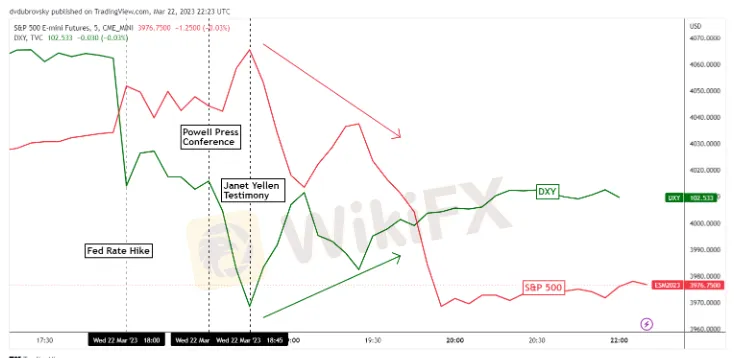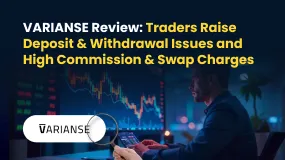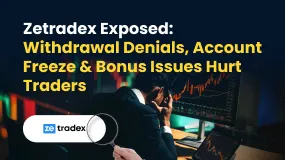简体中文
繁體中文
English
Pусский
日本語
ภาษาไทย
Tiếng Việt
Bahasa Indonesia
Español
हिन्दी
Filippiiniläinen
Français
Deutsch
Português
Türkçe
한국어
العربية
S&P 500 Sinks After Powell Speech and Yellen Testimony, Will US Dollar Rebound?
Abstract:The S&P 500 sank 1.6% on Wednesday in the aftermath of March’s Federal Reserve interest rate decision and accompanying press conference from Chair Jerome Powell.
S&P 500, US DOLLAR, JEROME POWELL, JANET YELLEN – ASIA PACIFIC MARKET OPEN:
The S&P 500 sank 1.6% in the aftermath of the Fed rate decision
Chair Jerome Powell tried pouring cold water on rate cut bets
Meanwhile, Janet Yellen testimony compounded risk aversion
Asia-Pacific markets appear to be bracing for volatility next
Asia-Pacific Market Briefing – Markets Reverse Gains on Fed Rate Decision
The S&P 500 sank 1.6% on Wednesday in the aftermath of Marchs Federal Reserve interest rate decision and accompanying press conference from Chair Jerome Powell. The central bank raised borrowing costs by 25 basis points, bringing the target range to 4.75% - 5%. Initially, markets welcomed the event as the statement noted that policymakers “anticipate” some extra firming might be appropriate.
That was cautiously downgraded from “ongoing increases” in the February statement, which was before Silicon Valley Bank collapsed earlier this month, triggering financial woes in the bank sector. But, markets turned after Jerome Powell noted that officials “just don‘t” see the case for rate cut this year. Since SVB’s bankruptcy, markets have been aggressively pricing in rate cuts this year.
A closer look reveals that median FOMC interest rate projections are still far more hawkish than what markets expect this year. Powell also stressed that if need be, they will raise rates higher than expected. The central bank also stressed that US banks are sound and resilient. Meanwhile, during Powells press conference, Treasury Secretary Janet Yellen was delivering testimony.
She noted that the government is not looking at offering “blanket” deposit insurance to stabilize the banking sector. This amplified selling pressure in regional banks, with First Republic Bank down over 15% by the end of the day. In the chart below, you can get a better idea of how price action evolved throughout these events and how the S&P 500 reversed and the US Dollar bottomed.
With that in mind, this is leaving Asia-Pacific markets vulnerable heading into Thursday‘s trading session. A lack of economic event risk is placing the focus on general market sentiment. As such, follow-through could dampen the mood for Japan’s Nikkei 225 and Hong Kongs Hang Seng Index. This may also offer some light for the US Dollar.

On the daily chart, the S&P 500 left behind a Bearish Engulfing candlestick. This followed what appears to have been a false breakout under a near-term falling channel from February. Further downside progress could open the door to resuming the downtrend. Immediate support is the 38.2% Fibonacci retracement level at 3938. Resistance is the 23.6% point at 4041.


Disclaimer:
The views in this article only represent the author's personal views, and do not constitute investment advice on this platform. This platform does not guarantee the accuracy, completeness and timeliness of the information in the article, and will not be liable for any loss caused by the use of or reliance on the information in the article.
Read more

WikiEXPO Dubai “Welcome Party” Concludes Successfully, Setting the Stage for the Main Event!
On the evening of November 10, 2025, the highly anticipated WikiEXPO Dubai “Welcome Party” was successfully held at the 6th Floor, Conrad Dubai, UAE. Serving as a “prelude” to the official opening of the expo, this event provided a high-end yet relaxed communication platform for representatives of global regulatory bodies, leaders of Fintech companies, renowned brokers, and senior executives of investment institutions.

VARIANSE Review: Traders Raise Deposit & Withdrawal Issues and High Commission & Swap Charges
Are you losing both while depositing and withdrawing your capital at VARIANSE? Does the broker give the currency conversion rate excuse for this? Have you been trapped with spreads charged higher than promised? Do you bear steep commission and swap charges at this broker? Traders frequently report these trading issues online. In today’s VARIANSE broker review, we have shared some trading complaints that have grabbed everyone’s attention. Take a look.

Is Fyntura a Regulated Broker? A Complete 2025 Broker Review
Fyntura is a broker accused by many users of posting fake reviews and running paid promotions with influencers to attract unsuspecting traders. Several users have faced withdrawal issues, blocked accounts, and manipulated trades. These are the real complaints and experiences shared by traders online. In this latest Fyntura Review 2025, you’ll learn about genuine user feedback, reported issues, and the broker’s credibility helping you make a better trading decision.

Zetradex Exposed: Withdrawal Denials, Account Freeze & Bonus Issues Hurt Traders
Do you constantly face withdrawal denials by Zetradex? Does the forex broker keep freezing your account and wiping out your capital? Have you also undergone issues concerning the Zetradex no deposit bonus? These trading issues have become apparent as the forex broker allegedly scams traders all over. In this Zetradex review article, we have demonstrated some complaints. Read them to get a feel of what happens to traders here.
WikiFX Broker
Latest News
BASF CEO: EU CO₂ Trading Is A "Destruction Mechanism" For European Industry
Is Fyntura a Regulated Broker? A Complete 2025 Broker Review
Zetradex Exposed: Withdrawal Denials, Account Freeze & Bonus Issues Hurt Traders
Is Forex Zone Trading Regulated and Licensed?
PINAKINE Broker India Review 2025: A Complete Guide to Safety and Services
Exness Restricted Countries List 2025 Explained
Is Uniglobe Markets Legit? A 2025 Simple Guide to Its Safety, Services, and User Warnings
Is Inzo Broker Safe or a Scam? An Evidence-Based Analysis for Traders
WikiEXPO Dubai 2025 “Welcome Party” Kicks Off Tonight!
He Trusted a WhatsApp Group and Lost RM659,000
Currency Calculator



